He's a patient man! I haven't been able to park my car in the garage since he startedM.V. wrote:It's all coming together mate, good work. You're a patient man!
Might have missed it, but what kind of numbers are you aiming for with the engine mods?
What did you do today? Cobba's rebuild
Moderators: trixynut, Mincehead, dicky, phuk72, Jak, Kevtrx849
- Rod.s
- Site Sponsor
- Posts: 1404
- Joined: Sun Apr 25, 2010 11:01 am
- Location: Brisbane, Australia
Re: What did you do today? Cobba's rebuild
If it's not made in China, it's a fake!
-
cobbadiggabuddyblooo
- Site Sponsor
- Posts: 6809
- Joined: Thu Aug 28, 2008 9:19 am
- Location: Brisbane,Australia
Re: What did you do today? Cobba's rebuild
Hopefully I pick up a nice 25yr old with long legs about 32 24 26 and a bank balance to match..M.V. wrote:It's all coming together mate, good work. You're a patient man!
Might have missed it, but what kind of numbers are you aiming for with the engine mods?
Not looking at chasing at any huge amounts of HP but looking for further gains in the midrange.
Any guesses???
I'll go for a conservative 95hp and 67 ft/lb.
Let's see how we go.
Any one else want a stab in the dark for a figure???
laughter is the best medicine
-
Trixed
- TRX-Enthusiast
- Posts: 341
- Joined: Sat Jan 26, 2013 4:07 am
- Location: Brisbane Aus
-
cobbadiggabuddyblooo
- Site Sponsor
- Posts: 6809
- Joined: Thu Aug 28, 2008 9:19 am
- Location: Brisbane,Australia
Re: What did you do today? Cobba's rebuild
Picked up the head today.. 
 and dropped the crank,rods and pistons off to have the piston valve cut out taken out 1 mm to accommodate the larger valves.
and dropped the crank,rods and pistons off to have the piston valve cut out taken out 1 mm to accommodate the larger valves.
I chose the Ross pistons as they are a 12:1 forged relief piston and a similar design as the std Yamaha piston.
They have a raised flat top and not domed like the JE pistons which should aid in the how the flame front manages to burn the fuel and swirl the fuel on intake and quench.
They also use the OEM 1mm oversize Yamaha rings and use the same principal to deal with piston rock with a concave shaped ring to keep a constant seal as opposed to the JE which has a wider ring gap and the rock is taken up by movement of the piston rocking in between the wider gap.
Both piston designs are the same using the oil scraper ring to feed oil onto the pin and under the piston for cooling.
They also have less weight and less surface friction area compared to a full skirt J.E. design.
This explanation basicly sums up most on the choice between the Ross and J.E. piston
There is nothing wrong with the J.E.878 piston but there is better and J.E. also make a similar designed forged relief piston but no readily available for a trx unless it's a special order.
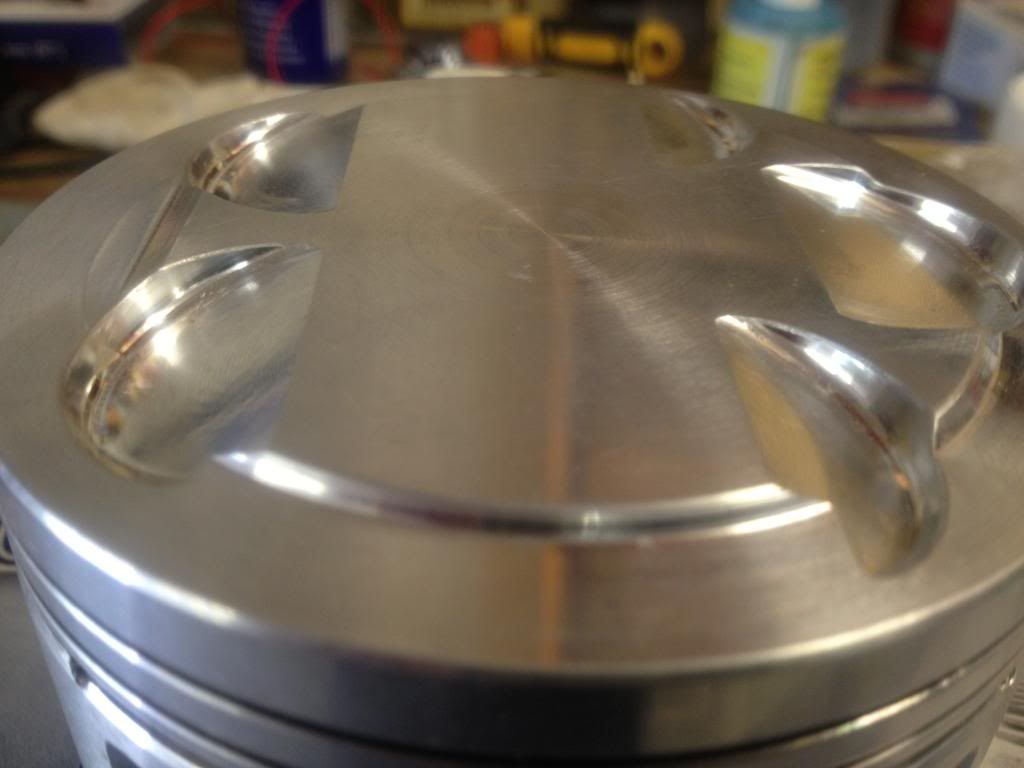

With the std OEM 849Yamaha piston...870 Ross piston and the JE 878
You can see the quench area on the Ross is a little wider to aid in cooling.

And the JE pistons for a comparison
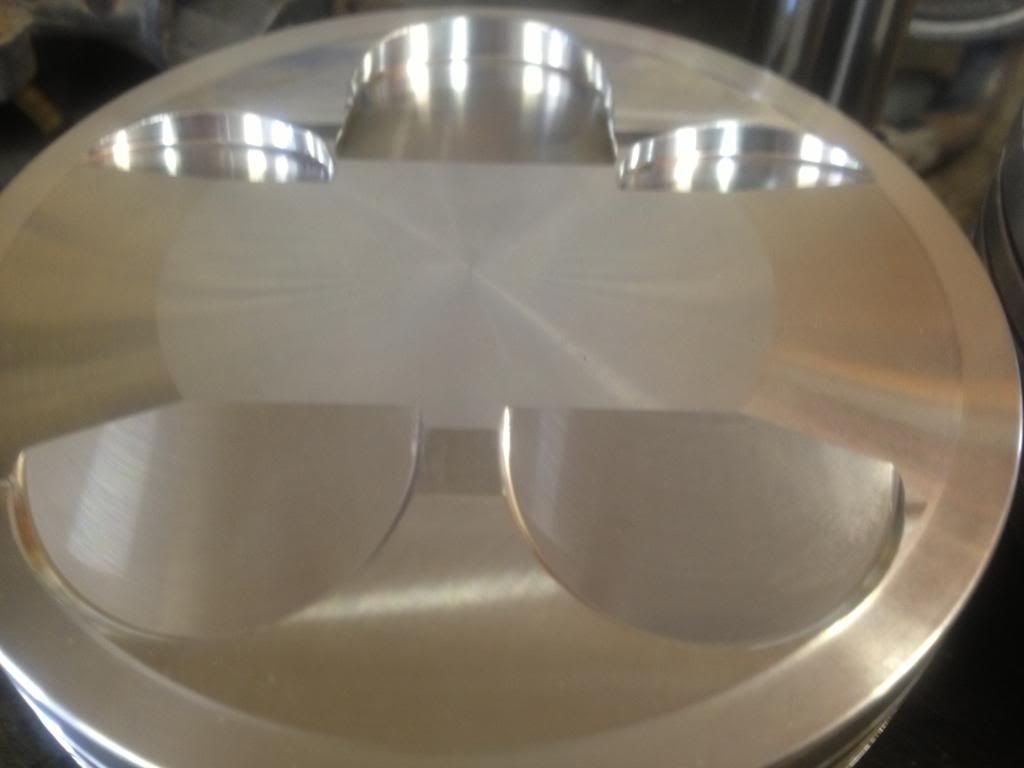

Flame Travel
Flame travel is one of the most important factors, so it's best to start here. Gasoline doesn't explode in your cylinders; it burns in an ever-expanding bubble called a flame front. Assuming the engine has some sort of swirl effect in the cylinder, as most do, the flame actually travels in something of a downward-moving vortex. A flat-top piston allows the flame front to disperse evenly along the piston head, whereas putting a dome atop the piston interrupts even flame front travel. So, all else being equal, the dome itself is almost guaranteed to cost you some power just because the mixture doesn't burn as evenly or as quickly as it could. In this case, the advantage in flame front travel goes to the flat-top piston.
Power Expression
The burning gases in your engine's combustion chamber move the piston by increasing cylinder pressure, as measured in pounds per square inch. Let's say you've got a flat-top piston with a diameter of 4 inches; a little math tells us it's got a surface area of 12.56 inches. If your combustion event gives you 200 lb. of pressure per square inch, you end up with 2,512 lb. of force pushing down on the piston. Now, put a triangular dome on top. The sides of the triangle have to travel a bit farther to span the piston's 4-inch diameter because they go up at an angle, resulting in more surface area. So, if you've got a dome that increases piston surface area by an extra 1.0 inches, the pressure on the piston is increased by extra 200 psi. For this reason, domed pistons have the advantage in power expression.
Sponsored Links
Gas Flow Calibration
Download a Free Best Practice Guide On Effective Gas Flow Calibration.
http://www.e.flukecal.com/CalibrationGuide
Weight and rpm
Weight is a major factor in piston design, primarily because it determines how high the engine can rev before snapping the piston's connecting rod. At high rpm, pistons experience acceleration forces measuring in the thousands of g's. At lower rpm, the piston may experience only about 400 g's of acceleration and deceleration. In other words, the piston exerts 400 times as much force on the piston as it weighs. At 10,000 rpm, the piston may see as high as 9,000 or 10,000 g's. At that kind of speed, an average flat-top piston weighing a moderate 500 g -- or 1.1 lb. -- would exert about 11,000 lb. of force on the rod. The addition of a 0.22-lb. aluminum dome effectively adds 2,200 lb. of load on the rod. The added weight can cause the connecting rod to snap and the engine to self-destruct at high rpm. Again, the advantage in weight and rpm goes to the flat-top piston.
Acceleration
Acceleration advantages between the piston types can be kind of a wash and depend largely on the engine. Extra mass means more weight to accelerate and decelerate, and as we've already seen, those accelerative forces can be pretty significant. Heavy pistons slow engine acceleration, which doesn't do much for performance, but more importantly they slow deceleration. An engine that decelerates slowly takes longer to drop in rpm between gearshifts, and that slows shifting. While this may sound somewhat nitpicky, piston weight can make the difference between slow, hard shifts and crisp, quick shifts. However, owing to the domed piston's increased surface area and superior power expression, you're not likely to lose any horsepower due to acceleration forces. In the end, the horsepower lost through acceleration is about the same between the two piston types, but the advantage in engine deceleration and shifting characteristics goes to the flat-top piston.
The Verdict
Consider domed pistons an item of last resort, to be used only if you've got a huge combustion chamber and desperately need the dome to increase compression to an acceptable level. While domed pistons do offer a few benefits in terms of power expression via increased surface area, dished pistons can do the same thing with far less weight penalty. About the only engines that really need dome pistons are those that use hemispherical combustion chambers; in this case, the chamber roof is so high and peaked that you almost can't maintain a decent compression ratio without a dome piston head. Otherwise, you'd do better to run a smaller combustion chamber and move the combustion event down into the piston with a dish. But this comes with a bit of a weight penalty versus a flat-top piston, so the dished piston is more suitable for large-displacement, low-rpm engines. All of this makes the flat-top piston preferable for most performance engines, particularly those that don't use hemispherical combustion chambers.
Read more: http://www.ehow.com/info_12224669_flat- ... z31fqfhBsE
I questioned the JE piston compression ratio when I saw them advertised by TTS (supplier) as 10.5:1. as most ,even myself thought these where 11.5:1.
This only confirms my suspicions as they are 10.5:1
viewtopic.php?f=37&t=3713&hilit=878+kit&start=15
Richard Albans (TTS) stated that the 878 pistons are 10.5-1 because the valve pockets are slightly deeper, but squish is improved through piston design. I told you that JE pistons were loads heavier Steve!! (joke)
I had to file a couple of the rings from my TTS kit slightly wider. TTS also don't bore the barrel as far as JE recommend, as JE produce predominantly car pistons, with clearances on the fitting instructions for V8's instead for bikes..
Make sure your gasket's bored as well.. The race is on for 878 rebuild - should get my engine back built mid next week. Tigcraft TRX is here!!!!!!!!!!!! (>100hp I hope)
I chose the Ross pistons as they are a 12:1 forged relief piston and a similar design as the std Yamaha piston.
They have a raised flat top and not domed like the JE pistons which should aid in the how the flame front manages to burn the fuel and swirl the fuel on intake and quench.
They also use the OEM 1mm oversize Yamaha rings and use the same principal to deal with piston rock with a concave shaped ring to keep a constant seal as opposed to the JE which has a wider ring gap and the rock is taken up by movement of the piston rocking in between the wider gap.
Both piston designs are the same using the oil scraper ring to feed oil onto the pin and under the piston for cooling.
They also have less weight and less surface friction area compared to a full skirt J.E. design.
This explanation basicly sums up most on the choice between the Ross and J.E. piston
There is nothing wrong with the J.E.878 piston but there is better and J.E. also make a similar designed forged relief piston but no readily available for a trx unless it's a special order.


With the std OEM 849Yamaha piston...870 Ross piston and the JE 878
You can see the quench area on the Ross is a little wider to aid in cooling.

And the JE pistons for a comparison


Flame Travel
Flame travel is one of the most important factors, so it's best to start here. Gasoline doesn't explode in your cylinders; it burns in an ever-expanding bubble called a flame front. Assuming the engine has some sort of swirl effect in the cylinder, as most do, the flame actually travels in something of a downward-moving vortex. A flat-top piston allows the flame front to disperse evenly along the piston head, whereas putting a dome atop the piston interrupts even flame front travel. So, all else being equal, the dome itself is almost guaranteed to cost you some power just because the mixture doesn't burn as evenly or as quickly as it could. In this case, the advantage in flame front travel goes to the flat-top piston.
Power Expression
The burning gases in your engine's combustion chamber move the piston by increasing cylinder pressure, as measured in pounds per square inch. Let's say you've got a flat-top piston with a diameter of 4 inches; a little math tells us it's got a surface area of 12.56 inches. If your combustion event gives you 200 lb. of pressure per square inch, you end up with 2,512 lb. of force pushing down on the piston. Now, put a triangular dome on top. The sides of the triangle have to travel a bit farther to span the piston's 4-inch diameter because they go up at an angle, resulting in more surface area. So, if you've got a dome that increases piston surface area by an extra 1.0 inches, the pressure on the piston is increased by extra 200 psi. For this reason, domed pistons have the advantage in power expression.
Sponsored Links
Gas Flow Calibration
Download a Free Best Practice Guide On Effective Gas Flow Calibration.
http://www.e.flukecal.com/CalibrationGuide
Weight and rpm
Weight is a major factor in piston design, primarily because it determines how high the engine can rev before snapping the piston's connecting rod. At high rpm, pistons experience acceleration forces measuring in the thousands of g's. At lower rpm, the piston may experience only about 400 g's of acceleration and deceleration. In other words, the piston exerts 400 times as much force on the piston as it weighs. At 10,000 rpm, the piston may see as high as 9,000 or 10,000 g's. At that kind of speed, an average flat-top piston weighing a moderate 500 g -- or 1.1 lb. -- would exert about 11,000 lb. of force on the rod. The addition of a 0.22-lb. aluminum dome effectively adds 2,200 lb. of load on the rod. The added weight can cause the connecting rod to snap and the engine to self-destruct at high rpm. Again, the advantage in weight and rpm goes to the flat-top piston.
Acceleration
Acceleration advantages between the piston types can be kind of a wash and depend largely on the engine. Extra mass means more weight to accelerate and decelerate, and as we've already seen, those accelerative forces can be pretty significant. Heavy pistons slow engine acceleration, which doesn't do much for performance, but more importantly they slow deceleration. An engine that decelerates slowly takes longer to drop in rpm between gearshifts, and that slows shifting. While this may sound somewhat nitpicky, piston weight can make the difference between slow, hard shifts and crisp, quick shifts. However, owing to the domed piston's increased surface area and superior power expression, you're not likely to lose any horsepower due to acceleration forces. In the end, the horsepower lost through acceleration is about the same between the two piston types, but the advantage in engine deceleration and shifting characteristics goes to the flat-top piston.
The Verdict
Consider domed pistons an item of last resort, to be used only if you've got a huge combustion chamber and desperately need the dome to increase compression to an acceptable level. While domed pistons do offer a few benefits in terms of power expression via increased surface area, dished pistons can do the same thing with far less weight penalty. About the only engines that really need dome pistons are those that use hemispherical combustion chambers; in this case, the chamber roof is so high and peaked that you almost can't maintain a decent compression ratio without a dome piston head. Otherwise, you'd do better to run a smaller combustion chamber and move the combustion event down into the piston with a dish. But this comes with a bit of a weight penalty versus a flat-top piston, so the dished piston is more suitable for large-displacement, low-rpm engines. All of this makes the flat-top piston preferable for most performance engines, particularly those that don't use hemispherical combustion chambers.
Read more: http://www.ehow.com/info_12224669_flat- ... z31fqfhBsE
I questioned the JE piston compression ratio when I saw them advertised by TTS (supplier) as 10.5:1. as most ,even myself thought these where 11.5:1.
This only confirms my suspicions as they are 10.5:1
viewtopic.php?f=37&t=3713&hilit=878+kit&start=15
Richard Albans (TTS) stated that the 878 pistons are 10.5-1 because the valve pockets are slightly deeper, but squish is improved through piston design. I told you that JE pistons were loads heavier Steve!! (joke)
I had to file a couple of the rings from my TTS kit slightly wider. TTS also don't bore the barrel as far as JE recommend, as JE produce predominantly car pistons, with clearances on the fitting instructions for V8's instead for bikes..
Make sure your gasket's bored as well.. The race is on for 878 rebuild - should get my engine back built mid next week. Tigcraft TRX is here!!!!!!!!!!!! (>100hp I hope)
Last edited by cobbadiggabuddyblooo on Tue Jun 23, 2015 7:22 am, edited 1 time in total.
laughter is the best medicine
- Rod.s
- Site Sponsor
- Posts: 1404
- Joined: Sun Apr 25, 2010 11:01 am
- Location: Brisbane, Australia
Re: What did you do today? Cobba's rebuild
Arh grasshopper, you have caught the fly 
If it's not made in China, it's a fake!
-
misterdimwiddy
- TRX-Enthusiast
- Posts: 474
- Joined: Thu Apr 08, 2010 6:14 am
- Location: Ware, Hertfordshire
Re: What did you do today? Cobba's rebuild
Are you planning to unleash it on the track when you are done 
Shame not to after all that performance work................
Shame not to after all that performance work................
- Gordo
- Site Sponsor
- Posts: 70
- Joined: Sat Jun 08, 2013 5:18 am
- Location: Brisbane
Re: What did you do today? Cobba's rebuild
Maybe I missed something, BUT......
If the valve is 1mm oversize in diameter, the piston valve cutout would be getting recessed only an extra half a millimetre, right?
I'm sure you got it sussed, but thought it better to post and remove all doubt.
Gordo-
- Rod.s
- Site Sponsor
- Posts: 1404
- Joined: Sun Apr 25, 2010 11:01 am
- Location: Brisbane, Australia
Re: What did you do today? Cobba's rebuild
Not recessed, but the cutout diameter increased by 1mmGordo wrote:
Maybe I missed something, BUT......
If the valve is 1mm oversize in diameter, the piston valve cutout would be getting recessed only an extra half a millimetre, right?
I'm sure you got it sussed, but thought it better to post and remove all doubt.
Gordo-
If it's not made in China, it's a fake!
- M.V.
- Site Sponsor
- Posts: 1509
- Joined: Sat Jul 04, 2009 3:23 am
- Location: Melbourne, Australia
Re: What did you do today? Cobba's rebuild
Yes, but an attractive young man with a full head of hair hanging out in your shed - the ladies must be flocking!Rod.s wrote: He's a patient man! I haven't been able to park my car in the garage since he started
That or your neighbours are starting to ask akward questions
- Rod.s
- Site Sponsor
- Posts: 1404
- Joined: Sun Apr 25, 2010 11:01 am
- Location: Brisbane, Australia
Re: What did you do today? Cobba's rebuild
The ladies are doing whatM.V. wrote:Yes, but an attractive young man with a full head of hair hanging out in your shed - the ladies must be flocking!Rod.s wrote: He's a patient man! I haven't been able to park my car in the garage since he started
That or your neighbours are starting to ask akward questions
If it's not made in China, it's a fake!
-
cobbadiggabuddyblooo
- Site Sponsor
- Posts: 6809
- Joined: Thu Aug 28, 2008 9:19 am
- Location: Brisbane,Australia
Re: What did you do today? Cobba's rebuild
Bit of an update on how things are progressing.
Crank pistons and rods balanced and valve cut outs have been taken out to accommodate the larger valves. Finished in 5 days..
I like the sounds of things when he said this should spin up a little faster giving me a little more out of the corners..
Got a call this morning too the pistons,valves and head ceramic coating is completed and ready to be picked up. Done in 2 days..
Done in 2 days.. 

Early next week I'll post up a few photos of before and after ceramic coating on the pistons and valves,chamber and exhaust ports plus photos / specs on the balancing .
Next week it's on the final phase of just having barrels bored, then everything cc'ed to give me my 12:1 compression ratio back and a thickness so I may get copper head gasket made to suit.
I'll get a couple of extras made at the same time and will work out cheaper than one from Yamaha.
Good thing about them is they will be reusable so if ever have to pull the head off again ,just anneal and use again saving you nearly $100.
I should have the cush drive rubbers made up to suit the dymag wheels too with a number of spares and last wheel spacer machined to suit the front Carrozzeria and new wheel bearings fitted..
Time to spend a few hrs then cleaning Rods garage so I can eat my dinner off it, ready to put it all back together in June..
Crank pistons and rods balanced and valve cut outs have been taken out to accommodate the larger valves. Finished in 5 days..
I like the sounds of things when he said this should spin up a little faster giving me a little more out of the corners..
Got a call this morning too the pistons,valves and head ceramic coating is completed and ready to be picked up.
Early next week I'll post up a few photos of before and after ceramic coating on the pistons and valves,chamber and exhaust ports plus photos / specs on the balancing .
Next week it's on the final phase of just having barrels bored, then everything cc'ed to give me my 12:1 compression ratio back and a thickness so I may get copper head gasket made to suit.
I'll get a couple of extras made at the same time and will work out cheaper than one from Yamaha.
Good thing about them is they will be reusable so if ever have to pull the head off again ,just anneal and use again saving you nearly $100.
I should have the cush drive rubbers made up to suit the dymag wheels too with a number of spares and last wheel spacer machined to suit the front Carrozzeria and new wheel bearings fitted..
Time to spend a few hrs then cleaning Rods garage so I can eat my dinner off it, ready to put it all back together in June..

laughter is the best medicine
-
cobbadiggabuddyblooo
- Site Sponsor
- Posts: 6809
- Joined: Thu Aug 28, 2008 9:19 am
- Location: Brisbane,Australia
Re: What did you do today? Cobba's rebuild
Just for conversation..
Had an interesting discussion with the Grant who was balancing the crank the other day on balancer shafts.
He use to be in the habit of removing these from motors for the gains of less drag and friction but after a in depth discussion with one of engineers from Ford. They had done extensive dyno work with balancer shafts removed from their motors and they found they really didn't gain anything due to the fact they found the harmonic problems and vibration from removing the shafts ,broke the fuel molecules apart slowing down the burn rate and loss of power which was offset by the less friction from the balancer shafts removed.
Plus with the shafts in place gave you a smoother power delivery down low.
Had an interesting discussion with the Grant who was balancing the crank the other day on balancer shafts.
He use to be in the habit of removing these from motors for the gains of less drag and friction but after a in depth discussion with one of engineers from Ford. They had done extensive dyno work with balancer shafts removed from their motors and they found they really didn't gain anything due to the fact they found the harmonic problems and vibration from removing the shafts ,broke the fuel molecules apart slowing down the burn rate and loss of power which was offset by the less friction from the balancer shafts removed.
Plus with the shafts in place gave you a smoother power delivery down low.
laughter is the best medicine
-
cobbadiggabuddyblooo
- Site Sponsor
- Posts: 6809
- Joined: Thu Aug 28, 2008 9:19 am
- Location: Brisbane,Australia
Re: What did you do today? Cobba's rebuild
Crank, rods and pistons all balanced up and Grant from Brisbane Engine Balancing has managed to get it all within 0.4 gram. With the Ross pistons only being a few grams heavier than the std TRX pistons to start and only need to shave a poofteenth off to get to where he needed.
STD piston/pin coming in at 409grams and 422grams for the Ross pistons/ Syd pin after having the valve relief fly cut for the 1mm larger valves.
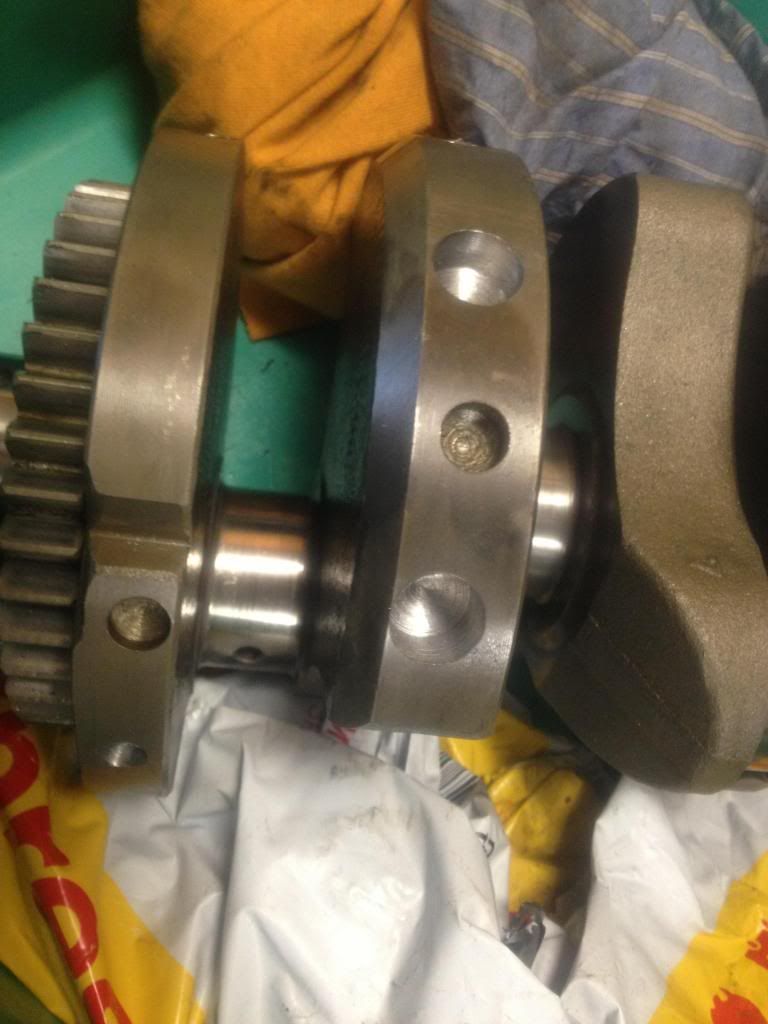
With the Carrillo rods being a lighter item by around 68grams than the std rods a little weight was taken off the crank weight as you can see by the 3 holes into the crank weight.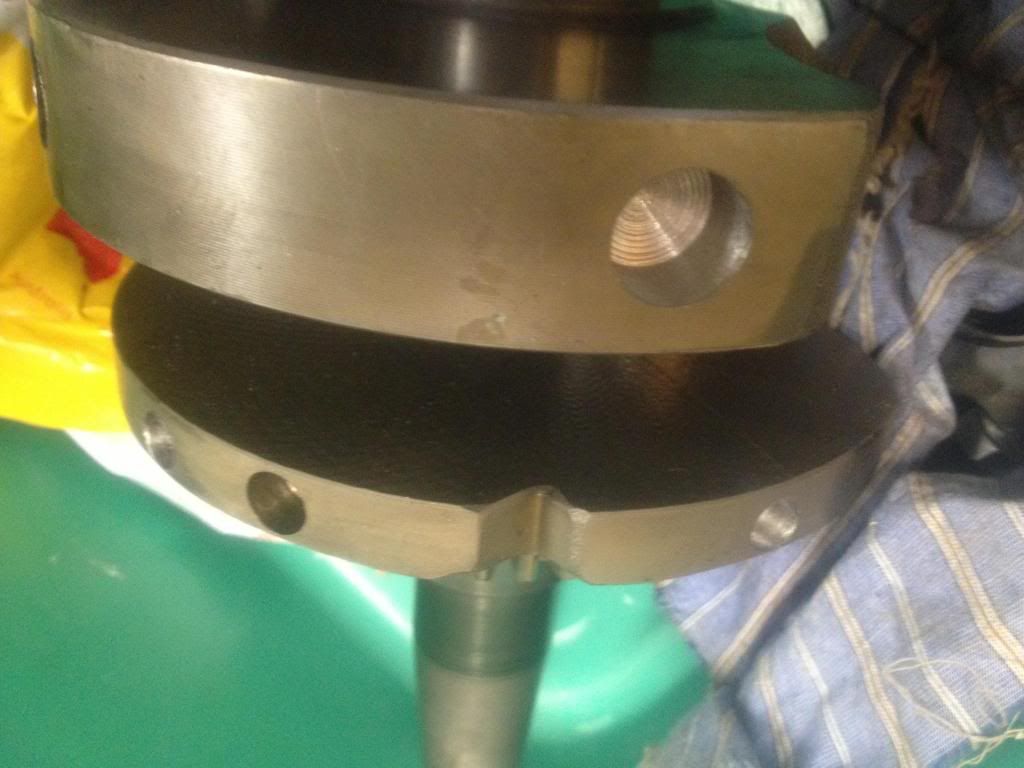
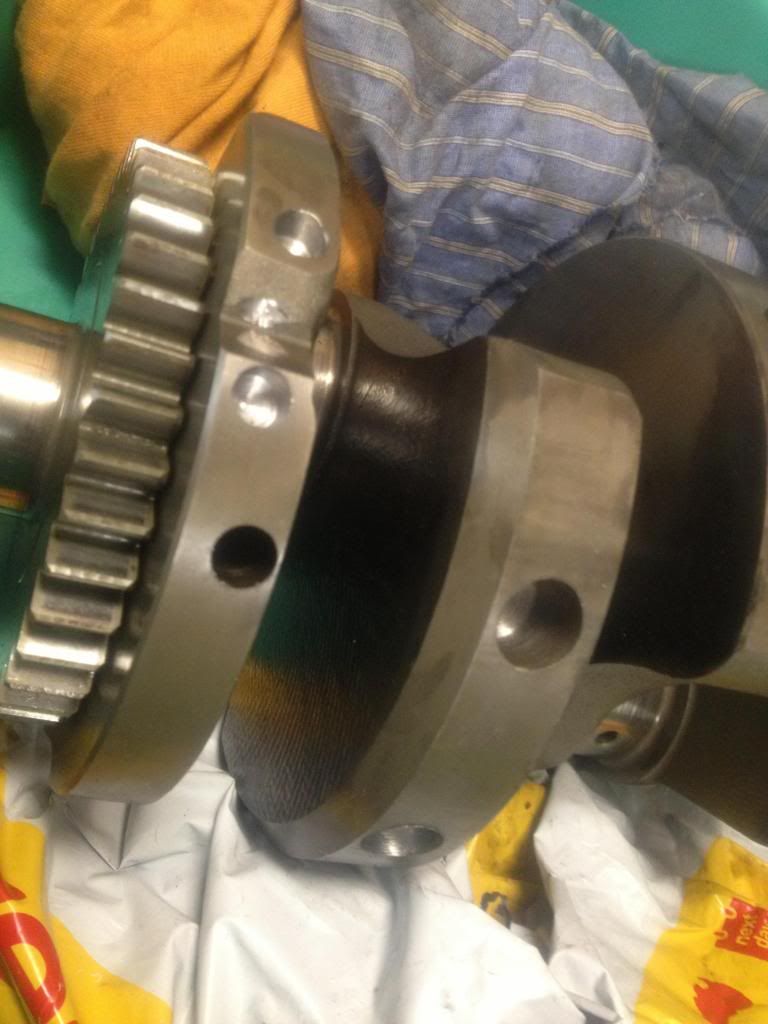
One thing I did was label the pistons,pins and rods to make sure each and every item goes straight back to the same position.
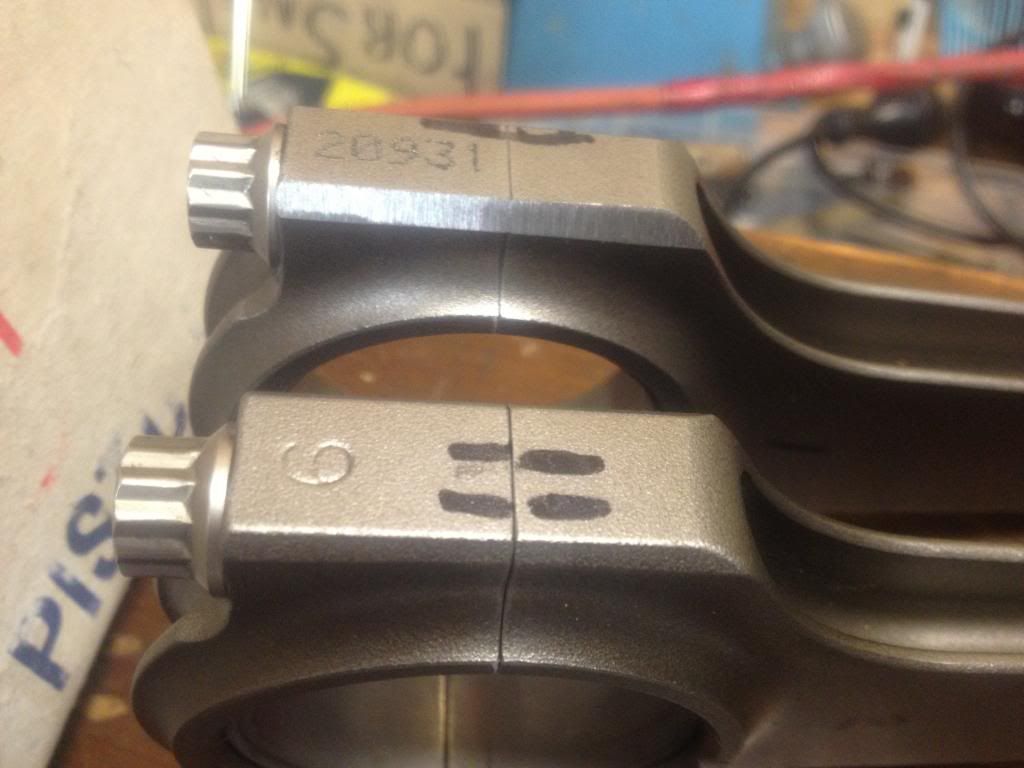
One thing I noticed straight away was a little weight taken off the base of No1 Carrillo rod and a light shave from the top of Rod no2. and 0.8grams difference between the pins so while at Competition Coating to get parts ceramic coated,he gladly marked each piston/pin with a reference so again hopefully making things idiot proof.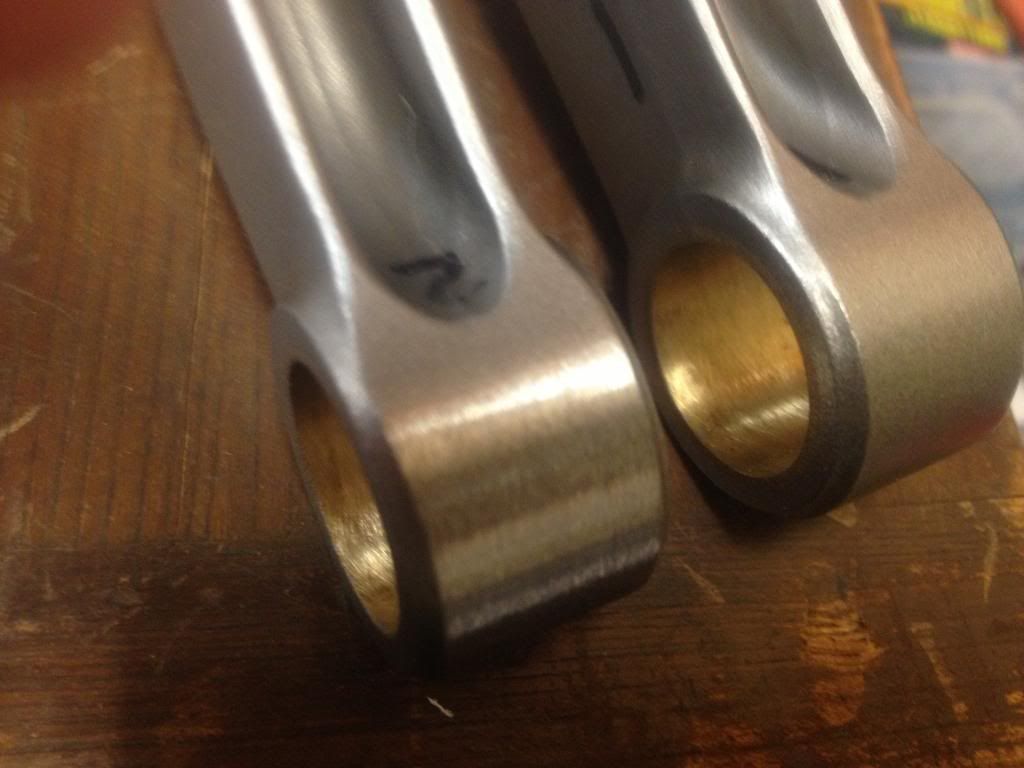
STD piston/pin coming in at 409grams and 422grams for the Ross pistons/ Syd pin after having the valve relief fly cut for the 1mm larger valves.

With the Carrillo rods being a lighter item by around 68grams than the std rods a little weight was taken off the crank weight as you can see by the 3 holes into the crank weight.


One thing I did was label the pistons,pins and rods to make sure each and every item goes straight back to the same position.

One thing I noticed straight away was a little weight taken off the base of No1 Carrillo rod and a light shave from the top of Rod no2. and 0.8grams difference between the pins so while at Competition Coating to get parts ceramic coated,he gladly marked each piston/pin with a reference so again hopefully making things idiot proof.

Last edited by cobbadiggabuddyblooo on Sun Mar 13, 2016 12:45 pm, edited 1 time in total.
laughter is the best medicine
-
cobbadiggabuddyblooo
- Site Sponsor
- Posts: 6809
- Joined: Thu Aug 28, 2008 9:19 am
- Location: Brisbane,Australia
Re: What did you do today? Cobba's rebuild
http://www.competitioncoatings.com.au/

So here we have the pistons with a before and after shot of the work done.
Here you can see the slight graining of the ceramic coat on the piston crown.
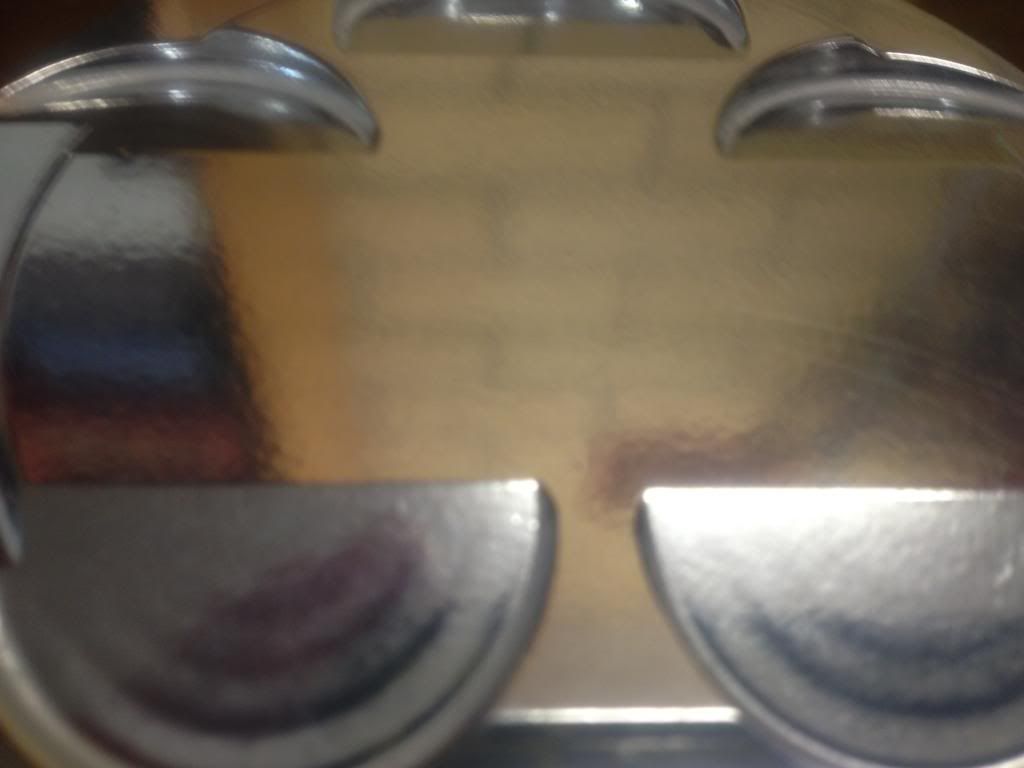
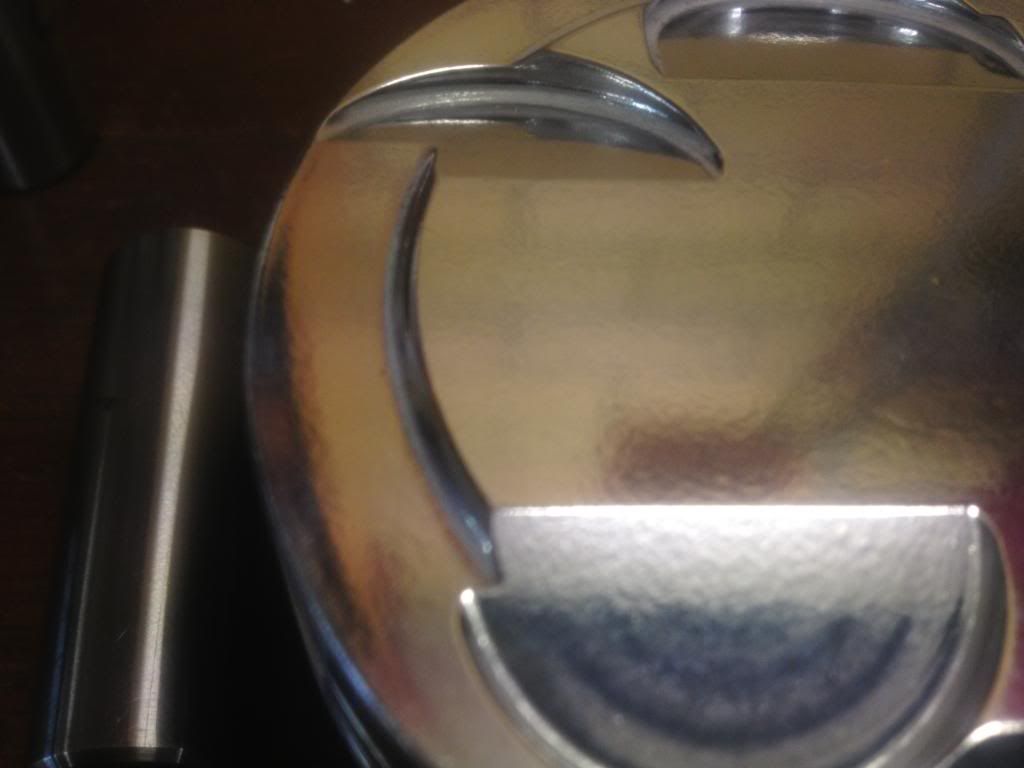
The advantage of coating pistons with BOTH Ceramic Thermal Barrier and Dry Film friction reducing coatings are:
Pistons are the engines weakest link when it comes to heat. How often will you read of competitors dropping out of races because of burned pistons. All good engine builders know that tunig an engine for “optimum leanâ€, maximizes horsepower by generating more heat in the combustion chamber. However, if too lean a mixture is run, pistons will be heat damaged (black death, skirt scuffing, “holed†pistons or missing top ring gland). Oxygen and fuel is spark ignited under compression to generate heat. The heat causes gaseous products of combustion to expand rapidly, forcing the piston downwards for the power stroke. Generating more heat causes more gas volume expansion (more H.P) but can also melt or burn aluminum pistons. Leaning down the air-fuel mixture to where oxygen is proportionally too high can cause metal to be burned away (oxidized), just like an oxy-acetylene cutting torch. Competition Coatings Ceramic Thermal Barrier will insulate from excessive heat and effectively protect from oxidation.
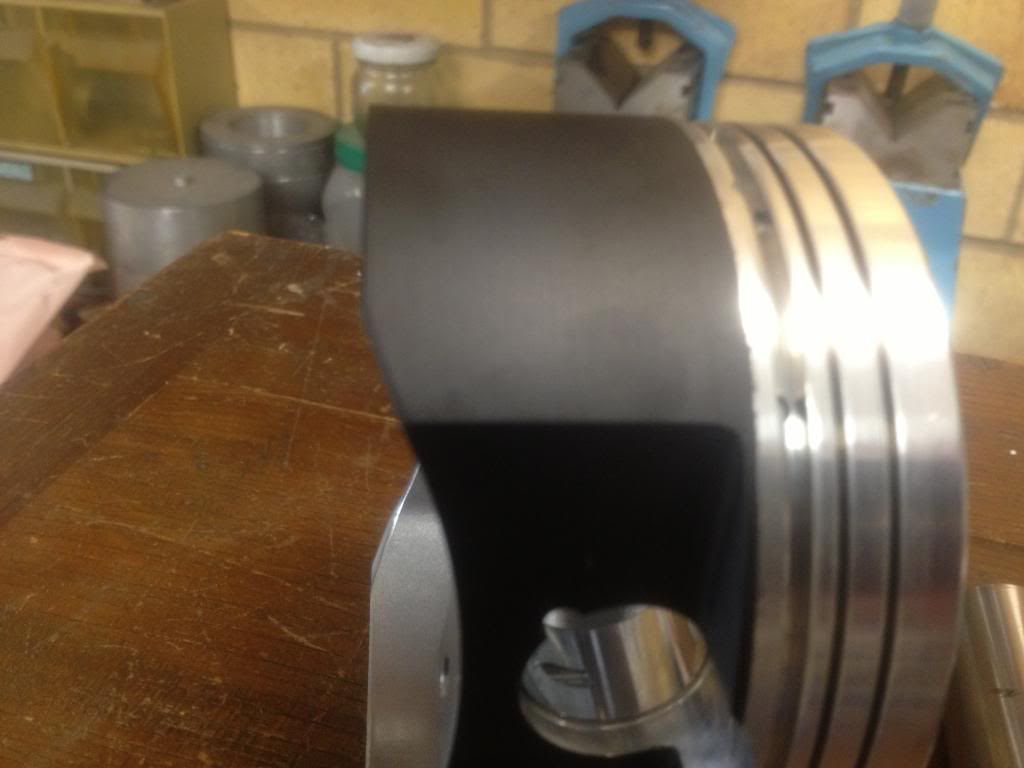
And thanks to Paul for with a little ceramic magic has labelled each piston to a specific pin.
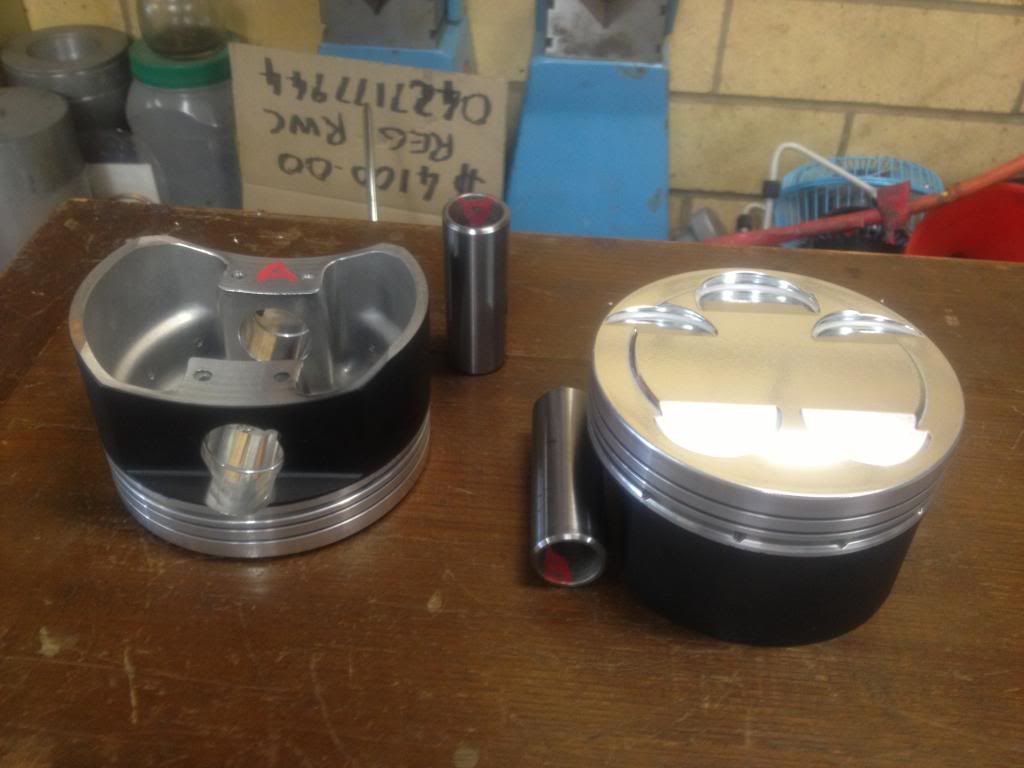

So here we have the pistons with a before and after shot of the work done.
Here you can see the slight graining of the ceramic coat on the piston crown.


The advantage of coating pistons with BOTH Ceramic Thermal Barrier and Dry Film friction reducing coatings are:
Pistons are the engines weakest link when it comes to heat. How often will you read of competitors dropping out of races because of burned pistons. All good engine builders know that tunig an engine for “optimum leanâ€, maximizes horsepower by generating more heat in the combustion chamber. However, if too lean a mixture is run, pistons will be heat damaged (black death, skirt scuffing, “holed†pistons or missing top ring gland). Oxygen and fuel is spark ignited under compression to generate heat. The heat causes gaseous products of combustion to expand rapidly, forcing the piston downwards for the power stroke. Generating more heat causes more gas volume expansion (more H.P) but can also melt or burn aluminum pistons. Leaning down the air-fuel mixture to where oxygen is proportionally too high can cause metal to be burned away (oxidized), just like an oxy-acetylene cutting torch. Competition Coatings Ceramic Thermal Barrier will insulate from excessive heat and effectively protect from oxidation.

And thanks to Paul for with a little ceramic magic has labelled each piston to a specific pin.

laughter is the best medicine
-
cobbadiggabuddyblooo
- Site Sponsor
- Posts: 6809
- Joined: Thu Aug 28, 2008 9:19 am
- Location: Brisbane,Australia
Re: What did you do today? Cobba's rebuild
After 11 months I finally got the head back from being ported and flowed and again thanks to Jeff Chesterton for a little of his artwork.
John while putting this all together for me has once again numbered each valve so when they have been removed for ceramic coating they can be placed back to exactly the seat they where cut for.
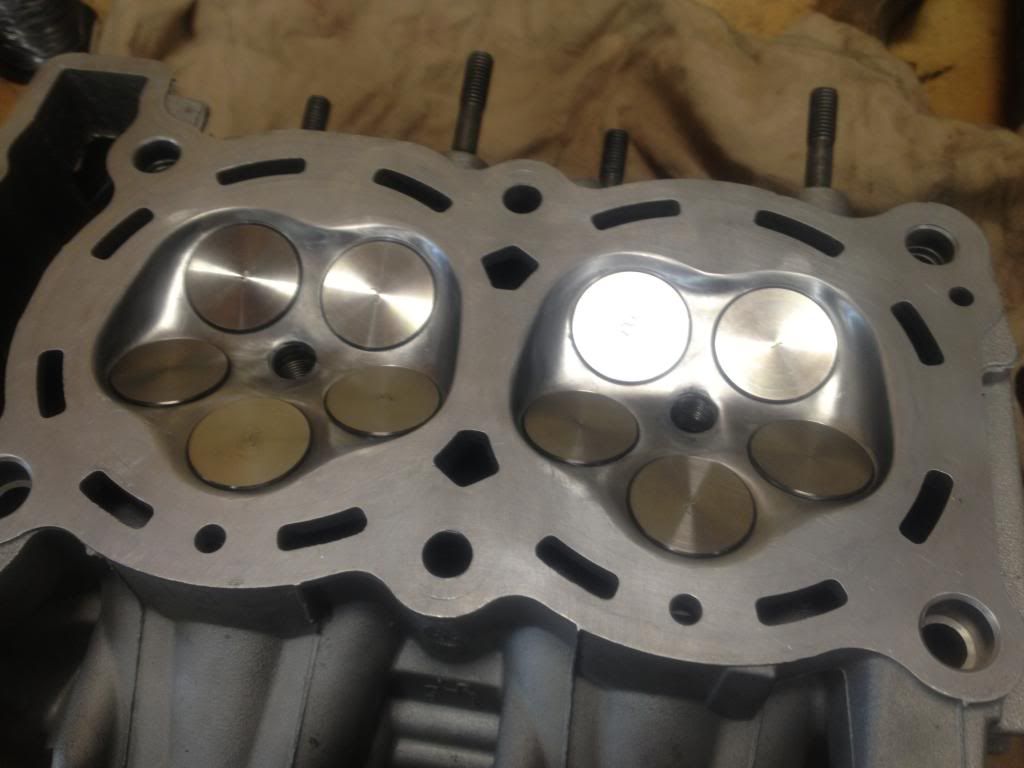
The advantages of coating a valve is to extend the part life and to reduce friction.
INTAKE valve seals the combustion chamber on the intake port side of the head, prior to that it is opening to allow air and fuel to enter the combustion chamber. Intake valves usually do not suffer as severely as exhaust valves which see combustion chamber temperatures. Therefore, the primary concern is lubricating the valve stem and seat. We do this by the application of a dry film lubricant. This reduces the friction particularly in engines where oil flow is restricted to the head. the dry film takes over the bulk of the lubrication chore. It is still advisable to coat the face of the valve in the combustion chamber to help retain combustion chamber heat in the combustion chamber. This also reduces the temperature of the back of the valve so that the incoming air/fuel mixture does not pick up as much heat from the valve, as it would, if is were not coated. Normally it is not necessary to thermal barrier coat the back of the valve, though it can be done if you wish.
EXHAUST valves experience a more severe environment because the valve is seeing combustion chamber temperatures, which on a normally aspirated engine can easily reach 730 degrees Celsius. So the face of the valve definitely gets a thermal barrier coating to reduce the amount of heat the valve will absorb. The back of the stem is coated with dry film lubricant. Again this is critical on the exhaust valve stem because the heat can reduce the ability of your oil to lubricate. Consequently the permanently bonded, high pressure, high temperature lubricants work extremely well at reducing friction and wear on the valve and the guide. In some cases, it is advisable to coat the back of the exhaust valve (such as with titanium valves where metal erosion can occur due to hot gas and flame passing over the valve). On other valves it is still preferable to coat the back with a dry film to contribute to the carbon shedding so a build up of carbon does not occur on the back of the valve which can create turbulence in the exhaust flow.
By coating the back of both intake and exhaust valves after all machining work is done you permanently bond the lubricant to the areas that will contact the valve seat thus reducing wear in this area and creating a better long term seal.
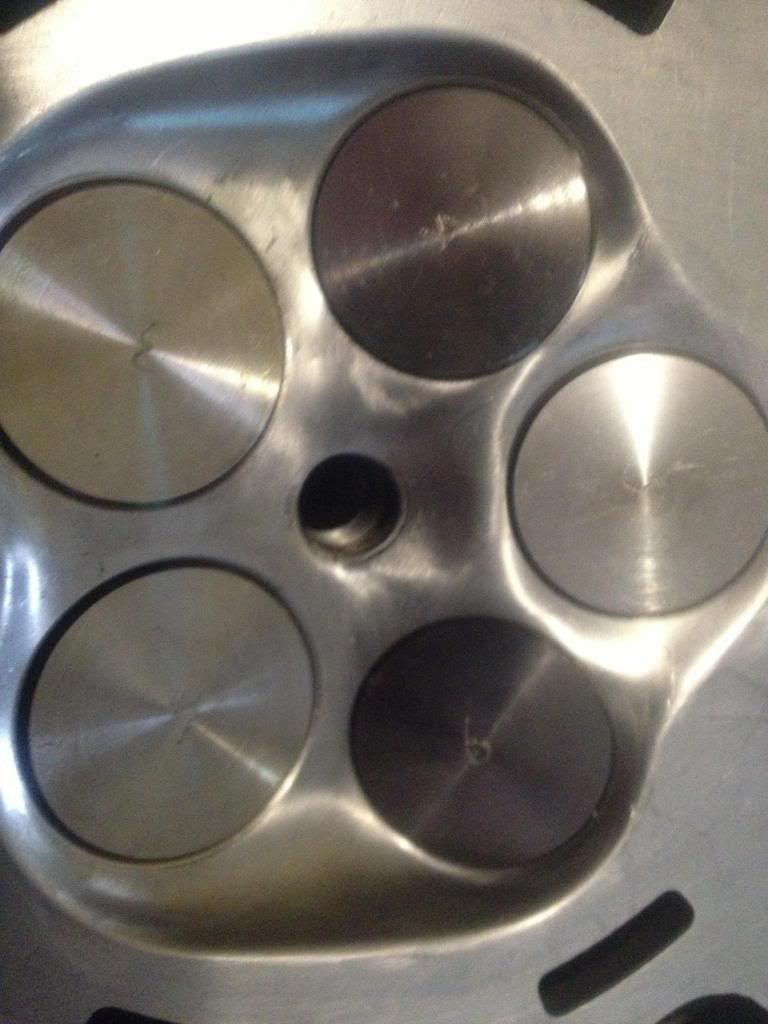

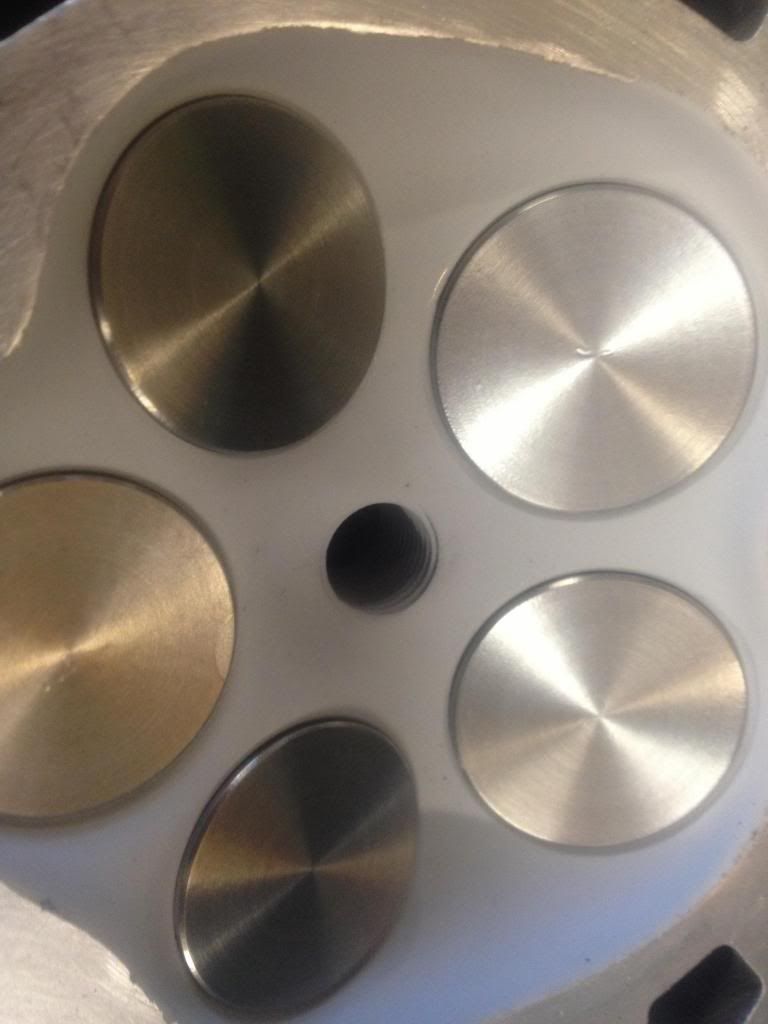
John while putting this all together for me has once again numbered each valve so when they have been removed for ceramic coating they can be placed back to exactly the seat they where cut for.

The advantages of coating a valve is to extend the part life and to reduce friction.
INTAKE valve seals the combustion chamber on the intake port side of the head, prior to that it is opening to allow air and fuel to enter the combustion chamber. Intake valves usually do not suffer as severely as exhaust valves which see combustion chamber temperatures. Therefore, the primary concern is lubricating the valve stem and seat. We do this by the application of a dry film lubricant. This reduces the friction particularly in engines where oil flow is restricted to the head. the dry film takes over the bulk of the lubrication chore. It is still advisable to coat the face of the valve in the combustion chamber to help retain combustion chamber heat in the combustion chamber. This also reduces the temperature of the back of the valve so that the incoming air/fuel mixture does not pick up as much heat from the valve, as it would, if is were not coated. Normally it is not necessary to thermal barrier coat the back of the valve, though it can be done if you wish.
EXHAUST valves experience a more severe environment because the valve is seeing combustion chamber temperatures, which on a normally aspirated engine can easily reach 730 degrees Celsius. So the face of the valve definitely gets a thermal barrier coating to reduce the amount of heat the valve will absorb. The back of the stem is coated with dry film lubricant. Again this is critical on the exhaust valve stem because the heat can reduce the ability of your oil to lubricate. Consequently the permanently bonded, high pressure, high temperature lubricants work extremely well at reducing friction and wear on the valve and the guide. In some cases, it is advisable to coat the back of the exhaust valve (such as with titanium valves where metal erosion can occur due to hot gas and flame passing over the valve). On other valves it is still preferable to coat the back with a dry film to contribute to the carbon shedding so a build up of carbon does not occur on the back of the valve which can create turbulence in the exhaust flow.
By coating the back of both intake and exhaust valves after all machining work is done you permanently bond the lubricant to the areas that will contact the valve seat thus reducing wear in this area and creating a better long term seal.


laughter is the best medicine